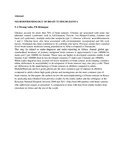| dc.contributor.author | Mwang'ombe, NJ | |
| dc.contributor.author | Kitunguu, PK | |
| dc.date.accessioned | 2013-11-29T15:59:19Z | |
| dc.date.available | 2013-11-29T15:59:19Z | |
| dc.date.issued | 2013-06 | |
| dc.identifier.citation | N J Mwang’ombe, PK Kitunguu;Neuroepidemiology Of Brain Tumours Kenya,presented at the 2nd International Scientific Conference, Chs And Knh, 19th - 21st June 2013. | en |
| dc.identifier.uri | http://hdl.handle.net/11295/61248 | |
| dc.description | Neuroepidemiology Of Brain Tumours Kenya,presented at the 2nd International Scientific Conference, CHS And KNH, 19th - 21st June 2013. | en |
| dc.description.abstract | account for more than 70% of brain tumours. Gliomas are associated
with some rare inherited tumour syndromes such as Li-Fraumeni, Turcoit, von
Hioppel-Lindau, Gardner and basal cell syndromes, multiple endocrine neoplasia
type 1, tuberous sclerosis, neurofibromatosis 1 and 2. Gliomas have also been
associated with environmental, occupational and life style factors. Irradiation has
been confirmed to be a definite risk factor. Previous studies have reported lower
brain tumour incidence among populations in Africa compared to Europeans.
This may be related to under-diagnosis and under-reporting in Africa. Annual
global age-standardized incidence of primary malignant brain tumours is
approximately 4 per 100000 for males and 3 per 100000 for females. These rates
are higher in developed countries (males 6 and females 4 per 100000) than in
less developed countries (3 males and 2 females per 100000).
While under diagnosis may account for lower incidence of brain tumour in
developing countries, ethnic differences in susceptibility to development of
brain tumours may also play a role. There are differences in the epidemiology of
brain tumours in children compared to adults.
Medulloblastoma and low grade glioma are the most common type of tumours
in children compared to adults where high grade glioma and meningioma are
the most common type of brain tumour. In this paper, the authors review the
neuroepidemiology of brain tumours in Kenya by analyzing data obtained from
previous studies by the senior author and his colleagues at the Kenyatta National
Hospital, between 2000 and 2011. Data from 400 patients with brain tumours
who underwent surgery is presented. A comparison is done with data from similar
studies done elsewhere in Africa and the rest of the world. | en |
| dc.language.iso | en | en |
| dc.publisher | University of Nairobi | en |
| dc.title | Neuroepidemiology Of Brain Tumours Kenya | en |
| dc.type | Presentation | en |
| local.publisher | College of Health Sciences | en |

